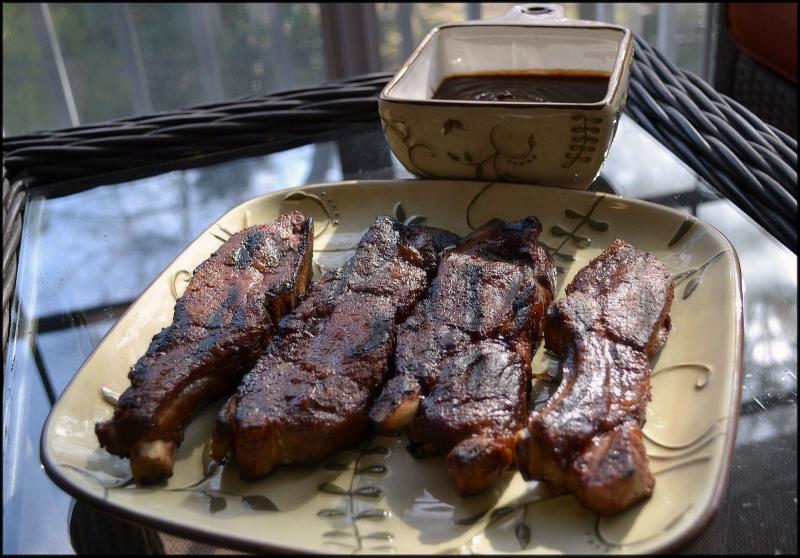Take your barbecue to the next level with tamarind
Once again, my friend Bob LaMorte has introduced me to an ingredient I hadn't seen before. Always an adventurous cook, his recent experiments included a barbecue sauce and a rich glaze featuring tamarind paste. The tamarind tree, native to Africa and Asia, has been around for centuries. Its sweet-sour fruit is a staple in Thai, Indian and Mexican cuisine, appearing in dishes such as pad Thai, Indian chutneys and Latin American aqua fresca (fruit soda).
The name tamarind is derived from the Arabic for Indian date, mentioned by medieval herbalists and Marco Polo for its medicinal value in aiding digestive woes (think prunes). By the early 1600s, the beautiful tree and its delicious fruit were introduced to the Americas, starting in Mexico and the Caribbean. You'll find specimens in this country thriving in the semi-arid regions of Hawaii, California and Florida.
Tamarind fruit grows in irregularly curved, brownish-colored pods ranging in length from 3 to 8 inches and about an inch in diameter. As it ripens, the pulp inside the pod dehydrates slightly, becoming thick and sticky. Harvesting the pulp requires removing the outer husk and rough fibrous strands inside. You can eat the pulp directly from the pod; just watch out for flat brown seeds.
To preserve the pulp for future use, simmer it in boiling water for 20 minutes and then mash it through a sieve to remove seeds and fibers. It will keep in the refrigerator in a sealed container for a week, or you can freeze it for up to a month. Since finding fresh tamarind is unlikely in Delaware, you can buy tamarind online. I don't recommend the packages of "fresh" pods, as they're often dried out; instead, choose jarred or canned paste (also called concentrate) or a "wet" block.
Wet versions of tamarind are just that, a block of unprocessed fruit pulp. You'll need to break off a chunk and soak it in water to create a dipping sauce, juice or paste (depending on how much water you add). Stir or mash the pulp to dissolve it in the water, then be sure to strain off any seeds and fibers (you'll always find some, even in the packages labeled seedless).
Nutritionally, tamarind is a good source of fiber, vitamins A and C, and essential minerals and phytonutrients. Due to its high acidity and sugar content, tamarind has a unique flavor profile, described as simultaneously sweet and sour. This ideal sweet-tart balance makes it a versatile ingredient, especially in combination with sugar to make a refreshing drink and popular Mexican candies.
The complex flavor of tamarind also works well in spicy sauces, marinades and soups. I've included Bob's recipes for barbecued ribs (see photo) and braised-glazed chicken thighs. You can also use the glaze over turkey meatballs for a sweet and savory twist. And, if you're not sure you've ever tried tamarind, check the back of your kitchen cupboard and read the label on that bottle of Lea & Perrins Worcestershire sauce.
Bob's BBQ Ribs
3/4 C ketchup
1/4 C water
2 T molasses
1 T Worcestershire sauce
1/2 t salt
1/4 t pepper
2 T liquid smoke
2 t chili powder
1/2 t granulated garlic
1 1/2 t tamarind paste
2 lbs bone-in country-style ribs
Preheat oven to 320 F. Coat the inside of a roasting pan with nonstick cooking spray; set aside. Whisk ingredients together (except ribs) in bowl or large glass measuring cup. Spread thin layer of sauce in the bottom of the pan. Arrange the ribs in a single layer in the pan and brush with a light coating of sauce. Cover the pan with aluminum foil and crimp edges tightly. Bake for 90 minutes. Shortly before ribs are done, preheat your grill to medium. Remove foil and brush ribs with a light coating of sauce. Place them on the grill sauce-side down. Cook just until browned, making sure not to burn the sauce. Brush the other side of the ribs with a light coating of sauce and turn over to brown the second side. Serve with remaining sauce. Yield: 2 servings.
Bob's Glazed Chicken Thighs
Braise:
4 bone-in skin-on chicken thighs
2 C water
1 C chicken stock
1/4 C dry sherry
1/4 C cider vinegar
1/4 C soy sauce
1 T coriander seeds
1 T fennel seeds
1 t peppercorns
3-inch cinnamon stick
Glaze:
1/4 C soy sauce
1/4 C brown sugar
1 T Hoisin sauce
1 T tamarind paste
1 T minced garlic
1 T minced ginger
2 t sesame oil
pinch ground cloves
2 T toasted sesame seeds
1 T vegetable oil
Rinse chicken and pat dry with paper towels. Heat a 12-inch nonstick skillet over medium-low. Place chicken in the pan skin side down in single layer. Cook until the skin is crisp and fat is rendered, about 30 minutes. Remove chicken to a plate; set aside. Wipe out skillet; set aside. In a Dutch oven, combine 1 C water, stock, sherry, vinegar, soy sauce, coriander, fennel and peppercorns. Break the cinnamon stick and add to the pot. Bring to a boil and add chicken in a single layer skin-side up. Water should only reach about halfway up the chicken pieces. Cover and reduce heat to low. Braise chicken until tender, about 60 minutes. While chicken is cooking, prepare glaze by combining remaining ingredients (except oil) in a small saucepan. Bring to a boil and simmer until thickened, about 3 minutes; set aside. Heat the reserved skillet over medium-high. Add 1 T vegetable oil. Once hot, but not smoking, arrange chicken in a single layer, skin-side down. Cook until crisp, about 3 minutes. Turn over chicken pieces and brush with a thick layer of glaze. Cook for about 2 minutes. Turn over chicken and brush glaze on the other side. Cook about 1 minute, taking care not to burn the glaze. Serve with remaining glaze. Yield: 2 servings.






















































